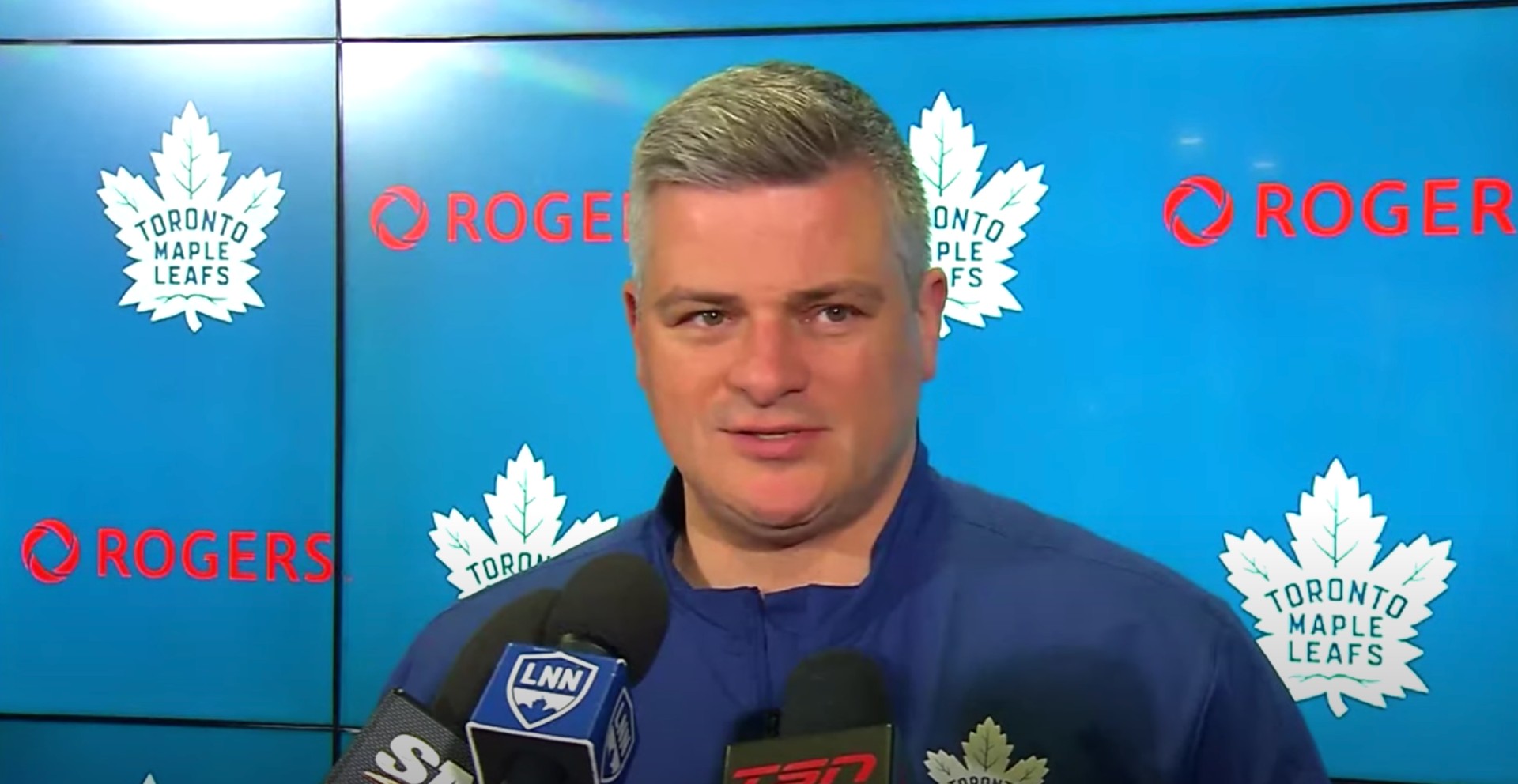After practice on Friday, head coach Sheldon Keefe discussed Auston Matthews’ two-goal game against Winnipeg, the decision to move away from the five-forward power-play unit, and Michael Bunting’s mouthiness on the ice and between the benches.
Practice Lines – January 20
Note: It is a maintenance day for Calle Järnkrok, who will play on Saturday in Montreal.
#Leafs lines at practice Jan. 20/23
Bunting-Matthews-Nylander
Hunt*-Tavares-Marner
McMann-Kampf-Engvall
AstonReese-Kerfoot-Simmonds
*Jarnkrok absent. @BodogCA @RinkWideTOR— David Alter (@dalter) January 20, 2023
#Leafs D-Pairs at practice Jan. 20/23
Rielly-Liljegren
Giordano-Holl
Sandin-Timmins
Extra: Benn@BodogCA @RinkWideTOR— David Alter (@dalter) January 20, 2023
Auston Matthews received a lot of attention for the big shot block yesterday, but in general, his shot block numbers are up this season. What are you seeing from him that is allowing that to happen?
Keefe: I always have taken him as a guy who is going to stand in front of a shot. As the low center, a lot of times, pucks are directed toward the net, and you are going to be in the line of fire. He stands in there and knocks those pucks down.
If the numbers are higher, it is maybe a sign that we have defended too much this year — meaning, we spend too much time in our end. But I have never had an issue with Auston’s willingness to stand in front of shots.
You mentioned that the way he took over the game against the Jets was similar to how he looked last year. What does he need to do to keep that going now?
Keefe: I just think it is the rhythm. I don’t think a player of his calibre is ever short of confidence, so it is not a confidence thing. But it is that rhythm. When you get in your groove, that is why most scorers are streaky. You get that feeling.
He has been pretty consistent in terms of his scoring, but he hasn’t had the big nights. Last night felt like a big night with the two goals in a short amount of time and a number of chances where it could’ve been four or five goals. He hit the crossbar on the breakaway.
Those are the kinds of nights that players of his calibre put together and then they go on good stretches and good runs of feeling good.
The two goals he scored were two completely different goals. He is getting different types of chances.
Keefe: For sure. If you look at all of his shots last night, there is a whole plethora of different looks there — the breakaway, and he scores another one off of a pass and goes high blocker, and he shoots five-hole a couple of times. He goes to the backhand on a couple. He used the full arsenal save for maybe the one-timer.
It wasn’t just the goals that went in but just the nature in which he was able to generate the other chances, how he was skating, and how he was getting to his spots. He was arriving at the right time when the puck was coming into the scoring area. Those are all timing things that seemed like it was all happening when he is at his best.
How relieving was it to see Timothy Liljegren back in practice after the scare in the game?
Keefe: Any time a puck goes flying in like that, you are not quite sure. It is a dangerous situation. We were put at ease quickly that he was going to be okay. From that sense, not a big surprise, but when it first happened, the reaction on the bench was one of concern for him for sure.
USA Hockey has a rule for U18 players that they are not allowed to ice the puck on the PK or it is blown down for a defensive-zone faceoff Looking at Mitch Marner’s goal last night, do you think the game is moving away from simply firing pucks down the ice on the penalty kill and more toward trying to make plays? Do you think that is where the game is going at the NHL level?
Keefe: I think there are a ton of benefits in youth hockey to play that way. My two boys have played a little bit in U.S. tournaments. They have experienced that. I have watched some of those games and I have seen it. I am a big fan of that.
Also, in the tournaments we were in, the penalties were a minute and a half as well instead of two minutes. They weren’t as long, which I think encourages more five-on-five play, and it is also positive for young kids to have that five-on-five mindset to hold onto pucks and make plays while also, at the same time, making it harder to kill penalties.
I don’t know if we will ever get to that point at the pro game or if it would make sense to, but at the youth level, I think there are a lot of benefits to maximizing how much time players can spend in that five-on-five mindset and making plays under pressure.
That said, at our level, when there is a play to go on a two-on-one or generate a scoring opportunity, you need to be able to do that. At the same time, if you make that mistake, it is that much more dangerous and there is so much more at stake at this level. At times, you just want to get it down, get a breather, and get off.
We have some players — Mitch leads the pack for us in this regard — who can make the right decision at the right time and make the other team pay for it. You want to be able to capitalize on it for sure.
You have departed from the five-forward power play for now. Is it a permanent move away, or is it something you might use situationally?
Keefe: I think what we learned is that it is something that can work for us. We scored some goals in that manner getting Mitch more time with the puck on his stick at the top making those decisions for us and also getting Michael Bunting to be a part of our power play. He scored us some big goals. We like that we can go to that.
That is really what it was if you look back. We had a 10-game set there where we were operating between 8-10% on the power play. It was really struggling. We needed to make a change.
We made the change just before Sandin got injured. Rielly was injured already. Our options were limited. It just made sense to try it. I thought it gave us a boost. We have learned it can work for us at times.
As I said at the time, I never looked at it as a long-term solution. The more you can try different things and learn about your group, it can help us.
The other part of it that came out of it is that Mitch is extremely comfortable at the top there. We can get more rotations and more movement. Even if we have a defenseman on the ice, it doesn’t mean he necessarily has to spend the whole time at the top.
How would you say Michael Bunting’s mouthiness on the ice and on the bench gets the time fired up or gets under the skin of the opponent?
Keefe: I think he can raise the emotion and the intensity of the game. As result, he can raise the temperature, which I think at times is very good for our team. It shows how competitive he is. At times, you have to tone him down to not cross the line — to stay focused and not hurt the team in that regard.
I like a lot of that fire that he has. It is a big part of his game. I think it adds a lot to the personality and emotions of our team.
What don’t we see from the outside about the impact goaltending coach Curtis Sanford has made this season?
Keefe: Probably the biggest thing would just be how consistent he is. He doesn’t get worked up too much one way or the other. He is very steady. He just works with the goalies and goes through the routine.
He is very level-headed. I think it comes from his own experience playing in the league — in particular, a Canadian market. He partnered for a while with Roberto Luongo, who was a great number-one goaltender and had a lot of pressure and responsibility that came along with it.
It fits his personality well. He is unfazed by anything that is happening outside of our walls. I think that allows our goalies to remain focused.
Are you going to give a longer runway to Ilya Samsonov or do you go to Matt Murray in Montreal?
Keefe: Sammy will go tomorrow.

































